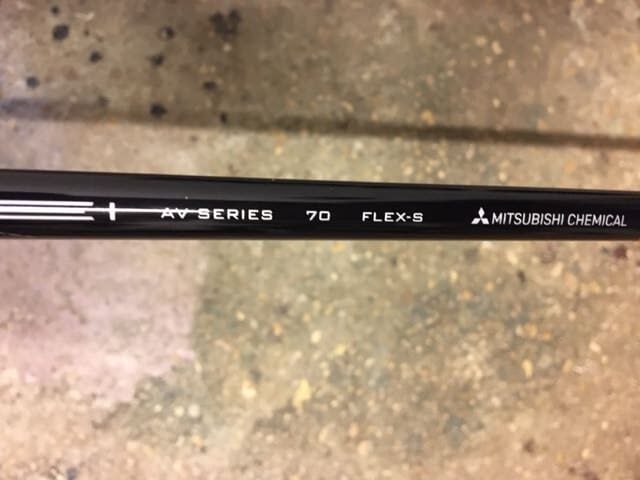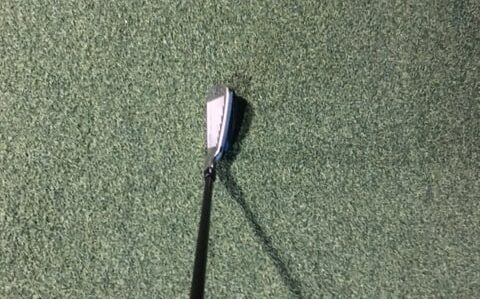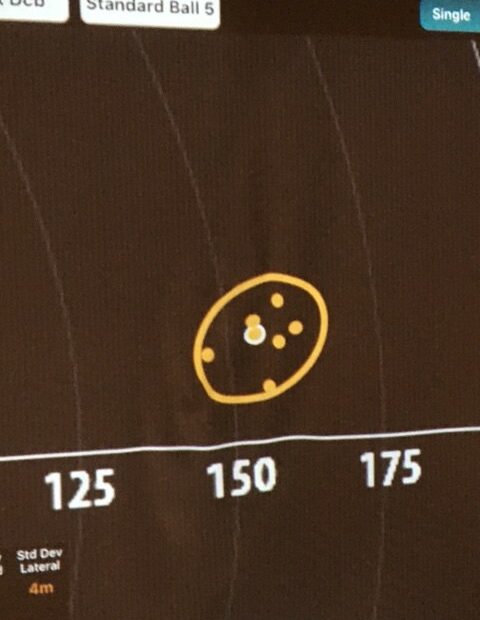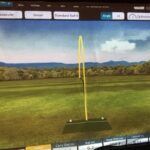Going through a fitting as I have recently done, is always an interesting experience (at least for me!) It gave me a huge amount of information about the current state of my swing as well as a good idea of what I should be playing. Or at least, what I should be playing if golf was played on a simulator hitting off mats indoors. This is the key part and something that many golfers forget. Golf is a game with a great many variables. Whatever the numbers look like on the computer, they need to work on the course and actually playing golf, otherwise it is all just a waste of time.
After my fitting, I am looking to move towards lighter graphite shafts. I am still swinging my seven iron at around 90 miles an hour and many (most?) people would be pointing me towards some sort of heavy steel shafts. As I have mentioned previously, I have a beautiful set of forged Mizuno irons with project x 6.5 shafts in. This is certainly a heavy, stiff shaft. However, despite what numbers might show, I know this isn’t for me any more. I have a few joint issues and I am fed up with that soreness the day after playing 18 holes. I wanted (and still want) easy and pain-free.
The Importance of On-Course Testing
This was my thinking going into the iron fitting and I came up with something that worked very well on Trackman. I had a couple of heads that made life very easy for me, the Wilson launchpad 2 iron and the Wilson d9 forged. The aim of this article isn’t necessarily to discuss the visual merits of various different types of clubhead (although it is important and we will come back to it later on in this article.) The shaft that gave this best numbers was a surprise. It is essentially a light, high-launch shaft, the Mitsubishi Tensei AV 70 Silver. It is in stiff flex, but overall a million miles from what I was playing before in terms of weight, flex and ball flight.

I went into my fitting with an open mind (which is key) and simply put, this shaft gave me a great combination of results and feel. It certainly launched the ball high, but I always hit it high, especially with the dynamic loft/flip I have in my swing. Honestly though, I am happy playing an ‘old man’s shaft’ if it lets me get out on the course pain-free and gives me control over the ball.
So what happens next? Well, this is the important bit and as I mentioned before, something that most golfers don’t actually do. I am lucky in that my fitting centre/golf shop (La Maison du Golfeur) is run by someone who knows the importance of what happens next. He simply gave me the two iron heads I was considering and the shaft and told me to go away for a week or two, try them on course and see what happened.
How Important is the Iron Clubhead?
Let’s come briefly back to clubhead design because it is important to this part. I have played all sorts of clubs from 1950s blades (yes, the leading edge is very sharp!) to hybrid irons. I do love blades and ‘pretty’ irons in general. The Wilson Launchpad is definitely not in that sleek eye-candy category! It isn’t ugly and in fact looks quite nice at address, but a blade it is not. The D9 forged isn’t a blade either, but it is a very aesthetically pleasing club. It certainly isn’t going to put many people off just through looks. Here is the launchpad 2 seven iron at address for example:

Here is a close up the Wilson d9 forged clubhead which is certainly a better looking iron for most people.

In terms of performance, the D9 was great on trackman. It gave me solid distance (154m/170 average carry) with a nice, controlled swing and the dispersion was excellent. Going out on the course, I would have been happy to see it win out over the launchpad. This isn’t to say that I didn’t like the launchpad. Even before playing it on the course, I was planning to look at at least a 5 iron in this head, maybe even a six and then perhaps blend into the D9 forged.
So what happened on the course? I went to a local course (Golf du Clou) which is one of my favourites. It isn’t a long course and there are very few forced carries. There are also a few 7 iron length par threes. This meant that my plan was to play the seven irons as much as possible, both off the tee and the fairway. Even if it meant playing for a lay up sometimes and chipping. It wasn’t about the score. In fact, laying up and chipping was also part of the plan because I was very keen to know how the seven irons performed in the chip and run. Spoiler alert, chipping with a hybrid or hybrid iron is really easy!
When doing this sort of testing, I find that you want to try to get as many head to head comparisons as possible. For example, I tried to hit a tee shot with each iron wherever possible. Likewise, for approaches. I was looking at ballflight, shot shape and dispersion as well as getting a feeling for how things felt.
Feel, Ballflight and Dispersion
There were a few interesting things that I hadn’t noticed so much in the simulator and that really showed the benefit of trying the clubs on the course itself. For example, it is almost impossible to overstate the importance of having confidence in a club. The launchpad iron just gave me an absolute ton of it. I was playing with a friend who knows what sorts of clubs I like and has seen what I have had in the bad over the years. He was, let’s say, skeptical that I would put the launchpad in the bag!
However, as I went on, I found myself preferring being at address with the launchpad. I was simply very confident of hitting a good shot. Here are a couple of examples.
About half way through the round, I hit it off the tee on a longish par four. This is really a driver hole in normal play. I felt so confident that I could really go after the ball a bit and also play a little draw off the right edge to give me a better line in. Sure enough, the shot went fine and did exactly what I wanted.
A couple of holes later, I had a par three over water to a green that is partially surrounded by water. I am usually a bit nervous on this tee even though it is only a seven iron. Short and left is dead and there is a tree on the right which makes the line tight. I hit both clubs off the tee. Both times, I felt like I could call the shot (a high draw back to the flag) and both times it worked.
Confidence is Key
This also brings me to the other key about testing on the course. I hit the d9 forged very well indoors. I also hit it fairly well outside. However, the more shots I hit, the more I noticed that front to back dispersion wasn’t as good as with the launchpad. On this hole for example, I hit the same shot basically twice, once with each club. Both felt like they came out of the middle. Both had a nice, high draw which I am used to seeing with my irons. However, the launchpad was pin high and the d9 was at the back of the green, a good dozen yards further on.
No problem, you might say, more distance. Well, yes and no. I am not anti-distance (who is?) but it isn’t my prime focus and I hate shots that fly further than expected. On the next tee, I had the same issue. Two tee shots, both well-centered and yet one was a club further.
This is the value of playing golf with a club, not just looking at numbers on a screen. The results were actually the opposite of what I might have expected. The hybrid iron was on average slightly shorter but very consistent with distance. In other words, exactly what I want from an iron and why many of us, myself included, tend to gravitate towards compact, ‘players’ irons’. The fact that I was getting this from a hybrid iron with a lighter shaft might go against what we would expect, but the results were there.
The next issue was ball flight. I hit a high ball and this is a hybrid made for popping the ball into the air on a high launch shaft. I certainly hit the ball high, but really, it wasn’t too high for me. It was still going forwards and not ballooning. Granted, there wasn’t much wind, but it was doing what I wanted and giving my very playable shots.
Of course, this sort of iron is all about forgiveness. In truth, I have mixed opinions about what forgiveness actually is in golf clubs. The reality of my game today is though, I need more of it than I used to. I hit a couple of very poor shots in terms of contact and this let me see just what sort of results I got. Generally, it has to be said, they were better than the shot deserved and this is important over a round or even a season of golf. This isn’t something you necessarily pick up on when going through the fitting itself.
Finally, there is one huge difference between playing indoors and out. when you hit off a mat, the lie is always perfect and in fact perfectly flat. Outdoors, this isn’t the case at all. However good a club looks or feels, if I can only hit it from a perfect lie, it isn’t any good to me because I spend as much time in the rough as the next guy! we should all be trying to play the shots we will actually have to play. This might mean off a side hill lie from the rough. This is a when a club earns its crust.
Fitting is Not (Only) on the Simulator
In truth then, this on course testing should really be the second part of every fitting. Certainly look at the numbers and play with all the variables from shaft weight to lie angle. Ultimately though, this is going to be a club for playing the game of golf. Nobody cares about your spin numbers. What is important is how you feel standing behind the ball and how confident you are hitting a shot into that tricky pin. The truth is that we should all play what we want. I am almost certain that I will still be hitting the course with a bag of butterknife blades far more often that I should. However, going through a fitting and then backing this up with some real on-course data is the best way to be confident that what you do eventually buy is going to work for your game.
As for me, this has helped me make a decision or at least part of one. I have ordered three Wilson launchpad irons (5,6,7) with a Tensei Silver stiff shaft, one inch overlength, 2 degrees upright and with jumbo grips. Will this help me on the course? I am certain that it will make some aspects of the game easier. It isn’t something that I would have bet on putting in the bag but I do trust the process.
You might be wondering exactly what is going to fill out the rest of the bag. To be honest, I am not sure but I am currently testing a couple of possibilities. If you have read any of my articles about one length irons, you will know how much I have enjoyed using them and one of the options is something that I have toyed with before and combines single length irons with these hybrid style irons. I will be writing a bit more about this when I have had an opportunity to test things out a little bit more but i think it could be a very interesting option for anyone who likes one length but perhaps struggles to use them all the way through the bag.






